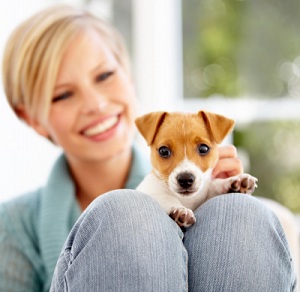- Home
- About Us
- Contact Us
- Privacy Policy
- What's New!
Housebreaking a Puppy
A Simple Action Plan
Housebreaking a puppy (or adult dog) is the act of teaching him never to eliminate in your home. This is not a difficult thing to teach a dog, if you do it properly.

But patience and consistency is required. The following is an action to help you housebreak your puppy in shortest possible time.
Each element of this action plan is designed to be done in 10 minutes or less. But for obvious reasons some elements of the plan will need to done several times each day.
The action plan is presented in the order you should do each step. So if you follow the instructions step-by-step, you’ll do just fine.
Prepare for Housebreaking a Puppy
Prepare Your Puppy
- Schedule an appointment for your puppy with your veterinarian today (if you haven’t already done so).
- Begin feeding and watering your puppy at 3 - 4 set times each day.
Prepare Your Home
- Borrow or purchase the necessary equipment (crates and/or gates) to set up a confinement area for your puppy.
- Purchase a good carpet cleaner designed specifically to eliminate pet stains and a deodorizer for pet odors, and use them whenever your puppy has an accident.
Prepare Yourself
- Carefully choose a toilet area outside and a single direct route that everyone in the family will always use.
- Choose 2 verbal cues and make sure everyone in the family knows how and when to use them.
- First verbal cue: “Outside.” When it’s time to take your puppy to go to his toilet spot, everyone should repeat this verbal cue. If you don’t particularly like this cue, you can choose another word or short phrase that makes sense to you.
- Second verbal cue: “Get Busy!” While your puppy is going potty, repeat this verbal cue. If you don’t like “Get Busy!” you can certainly choose something else (such as “Go Potty!” or “Go to it!” for example). Just use whatever phrase you choose consistently.
- Make sure that everyone in the house understands when to take your puppy to outside (10 to 15 minutes after eating or drinking). Also, begin to pay attention to your puppy’s particular signals that he will give before he eliminates and watch for them.
- Make sure everyone understands and follows the same procedure for taking your puppy outside. They should follow the same route outside, take your puppy to same location, use the same verbal cues, and praise him when he’s successful. Remember that consistency is vital!
- Keep whatever you may need for a trip outside (such as shoes, boots, flashlight, umbrella, jackets, etc.) near the door that you’ll always use.
- Remember, you must accompany your puppy outside at least until he’s fully housebroken.
Begin Crate Training
See Dog Crate Training - The Right Way. While crate training is a wonder help when it comes to housebreaking a puppy, it’s very important that you use this tool correctly!
- As soon as you have a crate, begin crate training and remember to always treat crate training as a happy event.
Housebreaking a Puppy Begins...
Once crate training is complete, you can begin housebreaking your puppy in earnest. If you choose not to use a crate, you will need to find some other means for confining your puppy when you're not able to watch him closely.
- Make sure to supervise your puppy whenever he is roaming free. Remember that puppies need this free time to play, explore their environment, and exercise. But they can still get into trouble and can have accidents if not properly supervised.
Whenever you’re home, you should...
- Provide regular trips outside every couple of hours (depending on your puppy’s age) during the day.
- Trips outside should come shortly after every meal.
- Supervision or confinement at all times while you’re housebreaking a puppy.
- Whenever you’re away from home for less than 2 or 3 hours, you should crate your puppy to encourage better control of his bladder and bowels.
- The length of time your puppy can be crated depends on his age and present ability to control his need to potty. Remember very young puppies have almost no such control.
- Make sure to take him to go potty just before you leave and immediately after you return.
- Whenever you’re away for more than 3 hours, confine your puppy to the confinement area you've prepared. Make sure to take him to go potty just before you leave and immediately after you return.
Work on being very consistent in all your interactions with your puppy…
- Practicing “immediate praise” whenever your puppy does what you want him to do. This will include going potty when and where you choose.
- And, practicing “immediate correction” whenever your puppy’s behavior is inappropriate. This will include any accident that you witness (and only when you have time to interrupt the accident).
- You can find more information about effective praise and correction methods on the Dog Obedience Training page.
Final Thoughts...
Remember the key elements of successful housebreaking a puppy (or dog):
- Control your puppy's intake of food and water (making sure that he's getting enough of both).
- Eliminate factors that could hinder housebreaking by taking your dog to your veterinarian.
- Manage your puppy's eliminations by feeding and watering him at set times and diligently using the technique of supervision and confinement.
- Praise your puppy's successes immediately and profusely so he'll want to repeat these actions.
- Correct his mistakes whenever you catch him (and only when you catch him) in the act and try to always catch him.
- After an accident has occurred, thoroughly clean the affected area so that all traces of the scent are eliminated.
- Never punish your puppy for having an accident. Remember that it is much more your fault than his because you failed to supervise or confine him.






